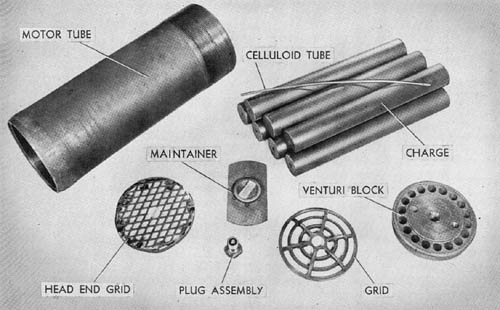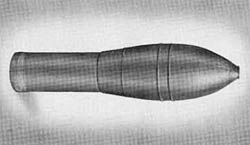
This rocket is packed in a wooden crate from which it may be fired in the same manner as the 28 cm rocket described on page 354. It is also fired from a rocket projector consisting of six welded metal frames mounted on a two-wheeled, split trailed carriage described on page 350.
This model has been selected to illustrate the construction of the motor assembly of a typical rotating rocket. The motor tube is 0.43 inch thick, closed at one end, and threaded inside to take the venturi block. Eighteen venturis are drilled in this solid block. The throat diameter of each venturi is 0.365 inch with an exit section of approximately 0.82 inch in diameter. The axes of the venturis are inclined at an angle of
Seven tubular sticks make up the propellant charge composed of nitrocellulose and diglycol dinitrate.

The sticks are supported at the venturi end on a grid. The center stick contains a length of quickmatch in a celluloid tube, and ending in a primed maintainer pellet. A small primer unit screwed into the steel venturi plug flashes directly on to the gun powder pellet at the end of the celluloid tube.
This motor unit is similar to that of the 15 cm Wurfgranate. However, because of the heavier charge in the 30 cm ammunition, the metal mesh has been introduced to prevent the maintainer pellet from being crushed by the central stick of the propellant charge if the rocket is dropped.
SPECIFICATIONS
| Weight of filled motor unit | 129 lbs., 10 ozs. | |
| Weight of filled bomb | 146 lbs., 4 ozs. | |
| Weight of propellant charge | 33 lbs., 3 3/4 ozs. | |
| Length (overall) | 47 ins. | |
| Length of bomb | 28.5 ins. | |
| Length of motor tube | 22.5 ins. | |
| Diameter of bomb | 11.8 ins. | |
| External diameter of motor tube | 8.56 ins. | |
| Length of propellant charge | 18.4 ins. | |
| Burnt velocity | 754 f/s | |
| Range, maximum | 4,976 yds. |
German: p. 354.1 (June 1, 1945)